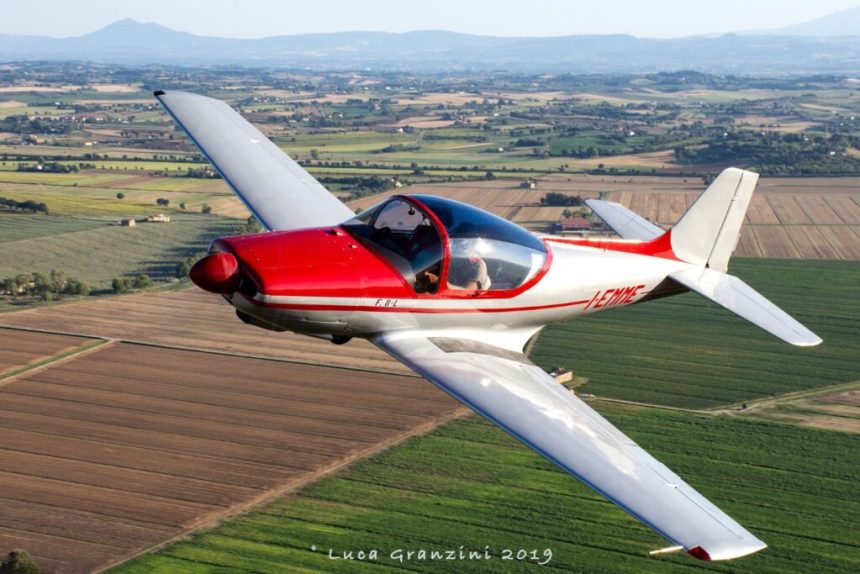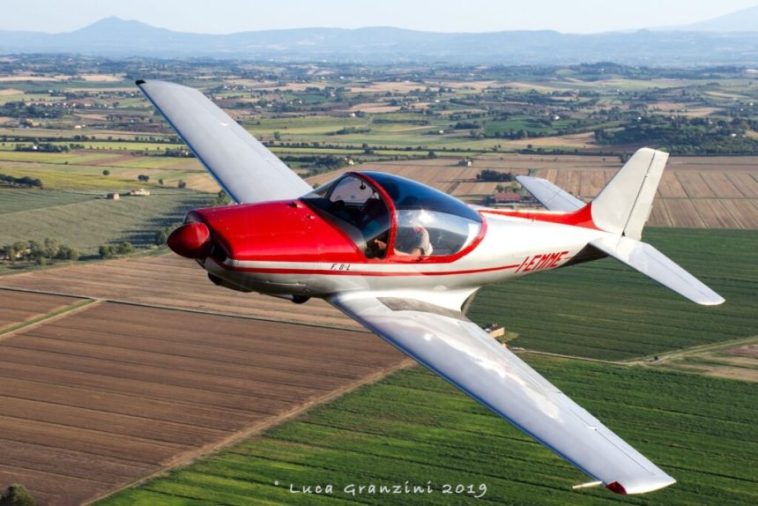
Celebrating the Aviamilano Falco: A 70-Year Journey in Aviation Innovation
This article takes a closer look at the legacy of the Aviamilano F.8-L Falco—a memorable two-seat wooden monoplane that has inspired generations of aviation enthusiasts. As we commemorate the 70th anniversary of its maiden flight, we also examine how the aircraft’s timeless design speaks to the imaginative spirit that propelled Italian sport aviation into the spotlight.
The Falco’s striking performance and aesthetics, often described as the “Ferrari of the Sky,” continue to spark wonder among pilots and collectors alike. In an era dominated by metal and composites, the wooden structure of the Falco stands as a tribute to an age when craftsmanship, passion, and vision were at the heart of aircraft design. As we celebrate this milestone, it is essential to reflect on the little details that make this aircraft a true masterpiece of the skies.
Honoring a Classic: The Legacy of Stelio Frati’s Design
Stelio Frati, the aeronautical engineer behind the Falco, crafted a design that remains influential more than seven decades after its introduction. His work sharply illustrates the combination of high performance and visual elegance—a blend that has not only set standards in light aircraft design but also influenced the development of renowned aircraft like the SIAI-Marchetti SF-260.
In every curve and line, the Falco captures the essence of a time when air travel was driven by passion rather than mass production. Whether used in training or sport aviation, the aircraft still soars across global skies, offering lessons in innovative engineering and design that continue to resonate with both aspiring pilots and seasoned engineers.
Innovative Commemorative Collectibles: The Limited-Edition Watch
In a fascinating twist that connects the past with modern trends, Hangar Italy has launched a limited-edition commemorative watch celebrating the Falco’s 70-year journey. This exclusive timepiece is not just a tribute to the aircraft—it is also a symbol of how tradition can blend seamlessly with modern design and technology.
Produced in a run of only 70 individually numbered pieces, the watch pays homage to the legacy of the Falco while embracing design elements that appeal to collectors and aviation enthusiasts alike. The timepiece was designed by Gianfranco Caprai, an architect and aerobatic pilot who is also the newly elected President of the Falco Club.
Caprai’s design integrates hand-drawn elements that mimic the sleek lines of the Falco, infusing the watch with a sense of history and mechanical passion. Every subtle detail on the dial echoes the graceful curves of the aircraft, offering a reminder of the charm and elegance that has made the Falco an enduring symbol in aviation.
Italian Craftsmanship and the Spirit of Innovation
Italian aviation has always been a blend of art and engineering—a sentiment clearly reflected in the creation of the Falco. Born in a modest workshop near Milan, the aircraft was designed for pure enjoyment of flight, combining brilliant aesthetics with remarkable performance. This marriage of form and function is a testament to the creative genius of the era.
The origins of the Falco shine a light on the inventive spirit of post-war Italy, where a renewed optimism and a drive for excellence led to advancements that reshaped the aviation industry. Designers like Frati turned even the trickiest parts of aircraft development into opportunities for innovation, crafting planes that remain beloved even today. The influence of the Falco can be seen in later designs and continues to serve as a source of inspiration for businesses and entrepreneurs in related fields.
Highlights of Italian Aviation Ingenuity
- Unique Craftsmanship: Detailed woodworking techniques give the Falco its distinct elegance.
- Performance Standards: The aircraft set new benchmarks for speed, agility, and maneuverability.
- Design Influence: Its aesthetic and engineering principles influenced later high-performance light aircraft.
These points underscore why the Falco is celebrated not only as a piece of aviation history but also as an ongoing inspiration for the design and engineering sectors, including small business operations and industrial manufacturing.
Impact on the Aviation Collectibles Market: A Business Perspective
The launch of the commemorative watch illustrates how nostalgic symbols from a bygone era can serve as powerful marketing tools in today’s marketplace. Small businesses and collectors find value in products that offer a tangible connection to the past, blending a deep appreciation for heritage with modern manufacturing techniques.
This initiative by Hangar Italy is a prime example of how companies can create products that resonate with both long-time enthusiasts and new audiences. The limited-edition watch, with its unique numbering and customizability, demonstrates a clever use of scarcity tactics—a strategy that boasts appeal in competitive markets.
Exploring Business Strategies in Aviation Memorabilia
For businesses aiming to tap into the nostalgia wave, the following strategies can be essential:
- Exclusivity: Limited runs generate urgency and desirability among collectors.
- Storytelling: Linking a product to a well-known historical narrative creates an emotional connection with customers.
- Quality Craftsmanship: Emphasizing artisanal details and superior quality distinguishes a product in a saturated market.
These considerations are especially important in the segments of industrial manufacturing and small business retail, where the fine points of design and the subtle parts of history can be leveraged to foster brand loyalty and customer engagement.
A Community of Enthusiasts: The Role of Aviation Clubs
Air clubs and aviation communities play a critical role in keeping the legacy of classic aircraft alive. The new watch, as well as other commemorative merchandise, helps strengthen ties within these communities, providing a common symbol around which members can rally.
Clubs such as the Falco Club, led by enthusiasts who both fly and study the history of aviation, offer platforms for sharing experiences, ideas, and even business insights. These groups often collaborate on restoration projects, host airshows, and participate in events that highlight the enduring significance of aircraft like the Falco.
Benefits of Joining Aviation Communities
| Community Benefit | Description |
|---|---|
| Networking | Meet individuals who share a passion for flight and innovation. |
| Educational Resources | Gain insights into the subtle details of historic and modern flight designs. |
| Restoration Projects | Collaborate on preserving aircraft that represent significant industrial achievements. |
| Event Participation | Take part in airshows, fly-ins, and heritage exhibitions that celebrate aviation history. |
The communal aspects of aviation culture are not only heartening but also serve as a strong economical driver, where local small businesses and international manufacturers alike benefit from shared passions that spur innovation and creativity.
Modern Techniques Meet Traditional Design
The celebration of the Falco and the launch of a commemorative watch highlight a broader trend: the intersection of traditional design and modern manufacturing. Today’s businesses, including those in industrial manufacturing and automotive parts production, are constantly finding ways to fuse classic aesthetics with cutting-edge technology.
In an age defined by rapid technological progress, many companies are now rediscovering the value of small distinctions in design that recall historical achievements. Whether it is in the aerospace industry, electric vehicles, or even business tax law consulting, there is a growing appreciation for products and services that honor heritage while pushing forward into the future.
Key Principles for Integrating Old and New Techniques
Business leaders looking to blend traditional design with modern production can focus on several essential factors:
- Quality Control: Ensure that modern processes remain faithful to the detailed craftsmanship of the past.
- Innovative Storytelling: Use historical narratives to market contemporary products compellingly.
- Cross-Industry Collaboration: Bridge the gap between different sectors—such as automotive, aviation, and manufacturing—to foster innovation.
These strategies not only help in crafting superior products but also create a narrative that appeals to a generation that values quality and authenticity over mere modernity.
The Role of Heritage in Shaping New Business Models
In today’s fast-paced market, businesses looking to capture consumer interest often struggle with the tangled issues of blending historical value with contemporary expectations. However, the successful celebration of classic aviation icons like the Falco demonstrates that heritage can be a key driver in creating products that resonate with modern audiences.
Brands that honor tradition while embracing modern technology and design are better equipped to handle the tricky parts of business innovation. By tapping into the legacy of historic designs, companies can foster aspirational connections with their target audience, whether they operate locally or on a global scale.
Steps Small Businesses Can Take to Embrace Heritage
Companies interested in integrating heritage into their product lines might consider the following practical steps:
- Product Collaborations: Partner with experts in history and design to create commemorative or limited-edition products.
- Marketing Campaigns: Develop narratives that highlight the evolution of design and the human stories behind technological breakthroughs.
- Customer Engagement: Use social media and community events to invite discussions on historical influences in modern products.
- Quality Storytelling: Invest in phrasing and visuals that clearly communicate the legacy of classic designs without making the narrative seem overwhelming.
By taking these steps, small business owners can create a unique selling proposition that differentiates their offerings in an increasingly competitive marketplace.
Economic and Cultural Implications for Small Business and Industrial Manufacturing
The celebration of iconic artifacts such as the Falco also provides a window into the broader economic and cultural impacts of heritage on industries like industrial manufacturing and automotive design. In many ways, these sectors stand on the shoulders of high-performance, beautifully engineered machines that once captured the collective imagination of the public.
As companies look to modernize and optimize their processes, they often find that small business agility and the old-school craftsman’s attention to detail remain essential. Whether figuring a path through the confusing bits of production challenges or embracing modern marketing tactics, there is a persistent need for quality and authenticity—a need that icons like the Falco aptly satisfy.
Economic Benefits of Leveraging Aviation Heritage
The aviation industry’s heritage offers several economic advantages that can be embraced by businesses across various sectors:
- Brand Differentiation: Heritage and nostalgia can create a strong brand identity that stands apart in the marketplace.
- Market Expansion: Limited-edition products and commemorative items attract both collectors and new customers, expanding the market base.
- Community Engagement: Vintage-inspired projects often foster a strong sense of community, leading to increased customer loyalty and support.
- Innovative Business Models: Combining modern techniques with historical themes can result in innovative business strategies that capture the public’s imagination.
For both industrial manufacturing and small business sectors, these benefits are crucial. They not only increase the economic value of products but also secure a lasting cultural legacy that reverberates across generations.
Balancing Nostalgia with Modernity: Lessons for Future Innovators
One of the key lessons from the Falco’s enduring success is the importance of balancing nostalgia with cutting-edge innovation. Modern businesses, especially those in high-tech fields like automotive engineering and electric vehicles, are continually challenged to maintain the fine points of traditional design while incorporating the latest technological breakthroughs.
Embracing historical legacies does not mean clinging to the past; rather, it involves using heritage as inspiration for creative problem-solving in today’s business arena. By taking the time to study the little twists and turns of classic designs, future innovators can pave the way for designing products that are both technologically advanced and deeply rooted in cultural identity.
Strategies for Modern Innovators
Future-forward businesses can consider the following approaches to build on heritage while pushing the envelope of modern innovation:
- Historical Analysis: Take a closer look at successful design stories from the past to extract lessons that apply to modern challenges.
- Customer-Centric Innovation: Listen to what your community values in heritage, and merge those insights with new technologies.
- Adaptable Design Processes: Create flexible production methods that honor traditional craftsmanship while leveraging automated systems where beneficial.
- Collaborative Platforms: Partner with museums, historical societies, and community groups to keep the conversation between the past and present active.
This balanced approach can ultimately help in creating products that not only meet the intimidating standards of modern markets but also evoke a sense of timeless style and reliability—qualities that are deeply appreciated by both longtime aficionados and new customers alike.
Embracing the Tangles and Twists of Heritage in Modern Business
In reviewing the legacy of the Falco, it becomes evident that embracing the tangled issues of history can lead to remarkable modern innovations. Although the process of integrating old-world charm with new-age methodologies may seem nerve-racking for some, it is, in many cases, the secret ingredient behind the success of innovative companies.
Modern businesses are learning that capturing the essence of historical achievements requires an honest commitment to quality, a willingness to get around tricky production challenges, and an openness to exploring fine shades of tradition and modernity side by side. The Falco not only represents an era of bold design but also serves as a case study in how historical narratives can light the way for turning complicated pieces of business strategy into beautiful success stories.
Learning from the Past: Key Takeaways
There are several crucial lessons that business leaders and innovators can take from the Falco’s extensive legacy:
- Embrace Simplicity: Even amidst the overwhelming modern market trends, simple and well-thought-out design continues to captivate audiences.
- Focus on Authenticity: Authenticity in design establishes trust and admiration among consumers, regardless of the industry.
- Blend Heritage with Innovation: Find your way through modern challenges by still honoring the classic roots that have set the standard for quality and performance.
- Create Emotional Connections: Products that tell a compelling historical story are more likely to resonate with customers on a personal level.
These takeaways are super important to drive not only the marketing narrative but also the manufacturing and product development processes that small businesses and larger corporations may adopt in their journey toward innovation.
The Broader Cultural Impact of Aviation Heritage
Beyond the practical economic benefits, the celebration of the Aviamilano Falco opens a window into the broader cultural influence of aviation heritage. Aircraft like the Falco are far more than machines; they are cultural milestones that mirror societal aspirations, dreams, and even the economic evolution of their eras.
The story of the Falco, from its humble beginnings in Pioltello to its status as a revered icon of Italian sport aviation, is a narrative filled with passion, creativity, and the willingness to push the envelope. This narrative not only inspires those in the aviation field but also captivates economic observers, marketing professionals, and small business leaders who see the value in stories that combine legacy with innovation.
Cultural Reflection Through Aviation
Aviation has always served as a mirror for society’s sense of adventure and progress. The Falco’s continued influence is a reflection of a time when innovative ideas were the driving force behind technological progress. By celebrating these icons, communities and businesses alike can acknowledge the historical roots that shape modern industries.
For instance, the spirit of the Falco influences several modern sectors:
- Aerospace Engineering: Historical designs continue to influence modern aircraft performance and aesthetics.
- Industrial Design: The elegance of classic design guides the development of contemporary products.
- Automotive Innovation: Heritage-inspired design principles are evident in luxury and sports cars that echo the style and performance of legendary aircraft.
These impacts stretch beyond economic figures, touching upon cultural identities and contributing to a legacy that informs both the present and the future.
Conclusion: Honoring the Past, Inspiring the Future
In celebrating 70 years of the Aviamilano F.8-L Falco, we recognize much more than an anniversary; we honor a tradition of innovation, creativity, and sheer passion. This iconic aircraft stands as a living reminder that even within the world of modern industrial manufacturing and small business strategies, tradition holds a crucial place.
The commemorative watch by Hangar Italy, with its unique design and limited edition run, perfectly encapsulates how heritage can be celebrated in a way that is both commercial and deeply personal. It is a testament to how businesses can find a path through the tricky parts and tangled issues of merging old designs with modern market demands, ultimately delivering products that are both a nod to history and a forward-looking innovation.
For those of us who admire the art of flight, the Falco is more than just an aircraft—it is a symbol of resilience, creativity, and the endless possibilities born when we combine the lessons of history with the drive for progress. As we look to the future, let the rich heritage of the Falco remind us that while the twists and turns of modern business can be intimidating, they also open up a world of new opportunities for those willing to celebrate the beauty of the past.
Small businesses and large-scale manufacturers alike can take inspiration from this legacy—finding valuable lessons in the fine points of classic design and adapting them to meet the needs of today’s dynamic market. Whether you are an entrepreneur seeking to highlight the authenticity of your brand or a collector looking to preserve a piece of aviation history, the story of the Falco offers a reminder that beauty, quality, and innovation are timeless treasures.
In the end, the celebration of the Aviamilano Falco is more than an airshow or a commemorative product launch—it is a tribute to an era when every aircraft was crafted with a sense of wonder and an unwavering commitment to excellence. Reminding us that the determination to maintain quality and innovation, even when faced with overwhelming modern challenges, remains a must-have ingredient in the recipe for enduring business success and cultural pride.
Originally Post From https://vintageaviationnews.com/warbird-articles/varese-celebrates-iconic-aircraft-70-years-of-the-falco-stelio-fratis-masterpiece.html
Read more about this topic at
Aviation’s Timeless Legacy by Pasquale De Marco
Watches of Switzerland on Instagram: “Timeless aviation …

